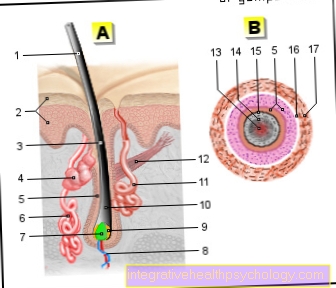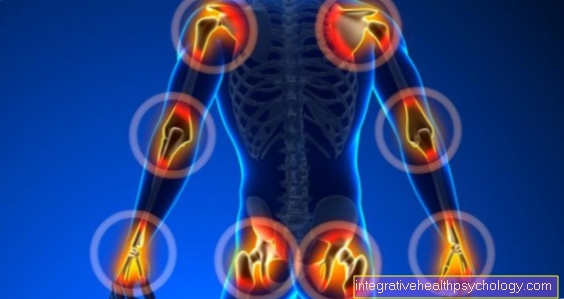Tendinitis in the thumb
introduction
Tendonitis of the thumb is usually understood to mean an inflammatory change in the tendon belonging to the thumb muscle, caused by an incorrect or overloading. Tendon inflammation usually results from excessive friction between the tendon and muscles, bones or surrounding tissue. Tendonitis can be very protracted. The course depends on the treatment measures initiated and, above all, whether the necessary protection of the tendon has been consistently carried out.
General information can be found at: Tendinitis
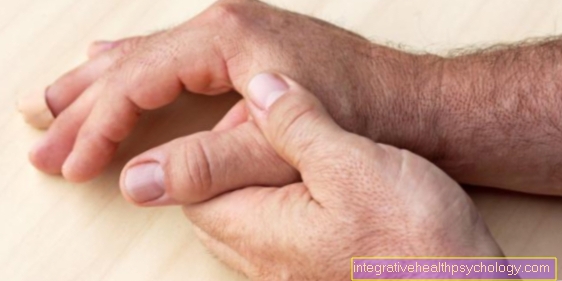
Symptoms
The first signs and complaints of tendinitis of the thumb are mostly pulling pain in the area of the thumb joint that occurs when the thumb is moved. The pain can be localized or directed towards the tip of the thumb.
If the tendonitis starts, pain only occurs when the thumb is moved. In the case of advanced tendinitis, pain can also arise at rest. Very severe tendinitis of the thumb is also noticeable as a slight swelling in the area of the tendon. The swelling in turn leads to increased friction in the area of the thumb muscle, which in turn leads to greater discomfort.
Also with severe tendinitis, mobility and movement impairment in the muscle area can occur. Movements that could otherwise be carried out without major problems are then only possible with great effort. In rare cases, the swelling can be so severe that it comes to swelling not only of the thumb joint but of the entire thumb, which can further restrict movement.
Pain as a symptom of tendinitis
The leading symptom of tendinitis of the thumb is primarily pressing but also pulling pains in the area of the thumb base joint. The pain can usually be triggered by moving the thumb, but can also occur at rest if the inflammation is advanced.
In the case of severe tendinitis, the Pull pain from the base of the thumb to the wrist. The reason is that the tendon of the thumb muscle runs through a tendon sheath that extends into the wrist. Together with other finger muscles of the hand, the tendon sheaths then run closely together in this area to below the wrist.
In the case of very pronounced tendinitis of the thumb, it can also happen that other tendon sheaths and thus also other finger muscles are affected by the inflammation and also start to hurt when moving.
therapy
Therapy for tendinitis of the thumb is almost always conservative, i.e. not performed surgically.
If the diagnosis of tendinitis of the thumb has been made, the thumb should first be spared. This can be guaranteed with a bandage. Regular cooling also leads to a rapid improvement in the symptoms. The rest and cooling should take place for a few days, under certain circumstances the intake of an anti-inflammatory drug can lead to a faster healing of the inflammation. Pain gels such as Voltaren, which are applied to the thumb joint, or, if the tendinitis is severe, anti-inflammatory tablets such as ibuprofen or diclofenac can also be used here.
The drug treatment should initially not exceed a week and if there is no improvement in the symptoms, a new diagnosis should be carried out to show whether the pain is possibly triggered by a cause other than tendinitis.
There are some cases where the tendinitis of the thumb is so severe and spreading throughout the wrist that surgical repair is required. An operation is always carried out when the inflammation of the thumb tendon has also spread to the tendon sheath and the tendon has stuck to the tendon sheath. In this case, normal movements in the thumb can no longer be carried out, which on the one hand would lead to severe pain during the attempted movement, but also to severe impairment of movement. The aim of the operation would be to expose the tendon sheaths on the open wrist and to make the tendon running in it glide again. Physiotherapy is urgently required after the operation to prevent the muscle from stiffening. In the vast majority of cases, however, conservative treatment is sufficient to cure tendinitis of the thumb.
Read also: Home remedies for tendinitis
Appointment with a sports orthopedic specialist?

I would be happy to advise you!
Who am I?
My name is dr. Nicolas Gumpert. I am a specialist in orthopedics and the founder of .
Various television programs and print media report regularly about my work. On HR television you can see me every 6 weeks live on "Hallo Hessen".
As a passionate athlete, I have specialized in the treatment of sports diseases for professionals and hobby athletes.
The focus is therefore on diseases of the muscles, tendons and joints.
In order to be able to treat successfully in orthopedics, a thorough examination, diagnosis and a medical history are required.
In our very economic world in particular, there is too little time to thoroughly grasp the complex diseases of orthopedics and thus initiate targeted treatment.
I don't want to join the ranks of "quick knife pullers".
The aim of any treatment is treatment without surgery.
Which therapy achieves the best results in the long term can only be determined after looking at all of the information (Examination, X-ray, ultrasound, MRI, etc.) be assessed.
You can find me in:
- Lumedis - your orthopedic surgeon
Kaiserstrasse 14
60311 Frankfurt am Main
Directly to the online appointment arrangement
Unfortunately, it is currently only possible to make an appointment with private health insurers. I hope for your understanding!
Further information about myself can be found at Dr. Nicolas Gumpert
Taping as a therapy for tendinitis
After the diagnosis of tendinitis of the thumb, immediate and consequent immobilization of the thumb is urgently needed. Most of the time, this can only be achieved with appropriate bandaging. As a rule, elastic bandages are sufficientwrapped over the thumb and adjacent parts of the hand.
There are also treatment approaches that use taping. The procedure, which is mainly known in orthopedics and trauma surgery, is intended to ensure that the normal Forces acting on certain muscles can be derived from other healthy muscles. In the case of tendinitis of the thumb, a short tape would be stuck exactly over the affected muscle. The tape, also called Kinesio tape is referred to is a elastic and self-adhesive tape that should be attached to the affected muscle areas without tension. It is also important that the skin on which the tape is stuck is dry and non-greasy so that the tape does not slip. The exact effectiveness of a kinesio tape has not been scientifically proven. However, there are many advocates, both on the patient side and on the practitioner side, for the treatment of various muscular diseases with a kinesio tape.
Bandages as therapy for tendinitis
While a kinesio tape has the task of relieving the affected muscle by transferring the forces to other muscles, a bandage is used for this Compression and immobilization. The most important conservative measure for thumb tendinitis is this consistent immobilization of the muscle. Since the thumb is used automatically as the most important part of the hand in every movement in everyday life, immobilization is usually only possible with a bandage.
Bandaging is done through the use of a elastic bandage. A special wrapping technique usually wraps the entire thumb (the tip of the thumb that remains free) up to the base of the thumb and beyond that to the wrist. It is important to ensure that a comfortable but clearly noticeable pull and pressure from the bandage is on the hand. The tip of the thumb should still be able to move easily but the area of the thumb joint should be clearly restricted in movement. It has been proven that in the case of muscular problems or joint problems, constant but still comfortable pressure on the affected joint, muscle or tissue leads to faster healing and pain relief.
Splint as therapy for tendinitis
Sometimes the tendinitis of the thumb may need to be so severe that the thumb must be completely immobilized. While parts of the tip of the thumb and the metacarpophalangeal joint of the thumb are still movable and can reasonably maintain movement in the hand when they are bandaged, a complete immobilization of the thumb without any freedom of movement can only be done by splinting.
When it comes to splinting, one is usually one today rigid rail made of plastic and put your thumb on it. Then the Fixation with an elastic bandagethat presses the thumb against the splint and makes it completely immobile. A splint can stay on the thumb for a few days to a few weeks.
From time to time the examiner should remove the splint and examine the thumb thoroughly. If the pain of the thumb under a splint has become significantly better, you can consider removing the splint and slowly training the thumb. Even after surgical interventions, with severe tendinitis of the thumb and after tendon sheath gluing, the thumb is usually splinted for 1-2 days to achieve faster healing.
Homeopathy for tendinitis
In addition to ointments and tablets, there are also some homeopathic approaches that have an anti-inflammatory effect on muscles and joints in the hand and thumb area. To choose the right homeopathic drug, many diagnostic questions are often necessary, which the homeopathic doctor asks the patient.
There it goes e.g. whether the pain in the joint is accompanied by other symptoms, e.g. a restlessness or a burning sensation is involved, etc. Then the appropriate anti-inflammatory drug is selected, which is then in the form of Globules is taken. Globules are small balls that should be taken sometimes every 30 minutes, sometimes less often during the day. After taking it for several days, the basic symptoms often worsen before the actual healing occurs.
In the case of an inflammatory disease in the area of the thumb and thumb joint, would Arnica montana and Ruta graveolens are used. Although there is still no scientific proof of an effect with homeopathic medicines, homeopathic medicine has also established itself as an accompanying and recognized treatment in conventional medicine.
Ointment for treating tendinitis
In addition to consistently immobilizing the thumb, attempts can also be made to accelerate the healing of tendinitis with cooling and anti-inflammatory ointments and gels. Primarily, ointments and gels that contain an anti-inflammatory agent are used for this purpose.
Ibuprofen gel (DocGel) or diclofenac gel (Voltaren®) would be used here. A treatment with kytta ointment can also be carried out, which also has a mild anti-inflammatory and cooling effect. If you apply the ointment or gel to the durem, especially the thumb joint up to the wrist should be covered with the ointment. The tip of the thumb can remain free. For better protection, an elastic bandage should then be wrapped over the thumb. An ointment or gel treatment can be repeated several times a day in order to achieve a correspondingly higher treatment effect.
Surgery as therapy for tendinitis
Surgical treatment of tendinitis is usually only used if either conservative treatments did not help and or the The inflammation of the thumb tendon has spread to such an extent that there has already been adhesions between the tendon sheath and the tendon.
In this case, access to the stuck and inflamed thumb tendon is made under sterile conditions and through an incision at the level of the wrist and the tendon sheath is opened. The sticky and inflamed thumb muscle running in it is then loosened and mobilized until it can slide back and forth normally in the tendon sheath. Then both the tendon and the wrist are closed again.
Meanwhile there is also some minimally invasive surgical techniques (keyhole technique)which makes it possible to access the affected tendons through the smallest incisions and to mobilize the tendons in the tendon sheath. After the operation, the thumb is usually splinted 1-2 days before the necessary one physical therapy to mobilize the thumb muscle can begin.
Duration
How long it takes for an inflammation of the thumb tendon to heal depends on the one hand on the severity and spread of the inflammation and on the other hand on whether a treatment was carried out consistently.
The more consistently the thumb joint is immobilized after the first signs of inflammation, the faster it will heal and the inflammatory reaction will be restricted.
A Muscle inflammation of the thumb that heals quickly is no longer a problem after a week do. Severe courses, as well as insufficient cooling or rest, may require a treatment of 2-3 weeks, sometimes even more than a month. If the treatment is not effective enough, a further diagnosis should definitely be made to determine whether the pain indicated is due to another cause.
causes
Muscles end in tendons that attach to the bone and ensure that the muscle can move smoothly. During a muscle movement, numerous frictional forces arise not only in the area of the muscle, but also on the respective tendons. This friction can cause irritation in the tendon areawhich then starts to ignite.
Some tendons lead through so-called tendon sheaths, which mainly have a protective function and reduce the friction forces. If there is strong friction and inflammation in such a tendon sheath, one speaks of one Tendinitis. However, all free-running tendons can also become inflamed by increased mechanical friction, which is then only referred to as tendonitis. Excessive friction almost always occurs due to an overload or an incorrect load conditions.
If movements in the thumb are particularly strong, or if the corresponding movement is unfamiliar, the friction can be so strong that the tendon and parts of the muscle begin to inflame.
diagnosis
Often times, tendinitis of the thumb is one clinical diagnosiswhich must be made without further diagnostics.
First, the patient is asked how long the symptoms have been in the area and whether particularly difficult or unfamiliar work has been done. After that, the doctor will examine the thumb joint and look whether the pain can be triggered by pressure or whether it persists at rest and during movement.
Reported thumb joint pain that occurs during thumb movement would be typical of the presence of tendinitis. If there is any doubt, one can too imaging examination through an ultrasound respectively. A tendinitis of the thumb would only be seen if the inflammation was severe, and also if the tendon sheaths are also affected. In this case, the tendon of the thumb would thicken or the tendon would stick together in the vagina.
The patient is asked to bend and extend the thumb. It is checked whether the tendon of the thumb slides in the tendon sheath as usual. If the tendon becomes stuck and does not move back and forth, there is a strong suspicion of tendinitis of the thumb. Other imaging methods, such as a MRI examination Due to the high costs and the lack of diagnostic superiority over clinical and ultrasound diagnostics, an MRI examination is only carried out if the findings are unclear or if the treatment is ineffective.
Inflammation of the tendons with involvement of the thumb saddle joint
The Saddle thumb joint represents the connection of the thumb to the metacarpal. It is responsible for most of the movements performed with the thumb. Osteoarthritis in this joint, which is relatively common, would be called rhizarthrosis.
Tendonitis of the thumb can sometimes be so pronounced that the inflammation travels up the muscle of the thumb and eventually reaches the joint of the thumb. This is usually only noticed by the patient increased pain on movement and pressure in the area of the thumb joint. Sometimes involvement of the thumb saddle joint can also lead to swelling in the joint, which can further restrict movement.
The treatment of tendinitis of the thumb with or without involvement of the thumb saddle joint is the same. A quick and regular cooling and immobilization of the thumb should be done a anti-inflammatory pain treatment with tablets can significantly accelerate the healing process.
A X-ray image occur, which would be clearly noticeable if the thumb saddle joint was involved.
How do I differentiate between tendinitis and osteoarthritis of the thumb?
Tendonitis in the thumb can have various causes, such as overuse or infection, and causes typical signs of inflammation. The affected area is red, swollen, warmed, painful and can affect the movement of the thumb.
In contrast to acute tendinitis, osteoarthritis in the thumb is a degenerative joint disease, without inflammation. Arthrosis in the area of the thumb saddle joint, rhizarthrosis, is very common and can cause pain, joint effusions and swelling, and impaired joint function.While tendonitis is an acute inflammation of a tendon of the thumb, osteoarthritis of the thumb develops over time due to joint wear and tear and typically affects the thumb saddle joint.
How do I tell the difference between tendinitis and gout attacks in the thumb?
Acute tendinitis shows up with the classic signs of inflammation, warming, reddening, pain and swelling in the area of the affected tendon. This can visibly restrict the ability of the thumb to move.
An acute attack of gout in the thumb is caused by the precipitation of uric acid crystals in the thumb joint. An attack of gout in the base of the thumb is called a chiragra. As with tendinitis, the thumb is painful, swollen and red. At the same time, an acute gout attack is often accompanied by a fever and a strong serous effusion. The swelling is localized around a joint and is much more pronounced than with tendinitis.
What is a cell phone thumb?
The term cell phone thumb describes a widespread disease associated with the massive use of smartphones and tablets. Most of the time, many people use their thumbs one-sidedly on their cell phones. While the actual movements that the thumb is designed for are grasping and clenching the fist, other, unhealthy movements are made with mobile phone movements. When using a mobile phone, stretching and splaying movements are carried out, which can damage the thumb in the long term. Fifteen to twenty-five year olds in particular suffer from a cell phone thumb. Those affected suffer from pain in the area of the inside of the thumb, in the ball of the thumb and sometimes even from pain on the inside of the forearm (thumb side). The cause of the complaints are changes in the tendons and muscles in the area of the thumb. The cell phone thumb is often associated with a poor posture in which those affected have shoulders pulled forward.


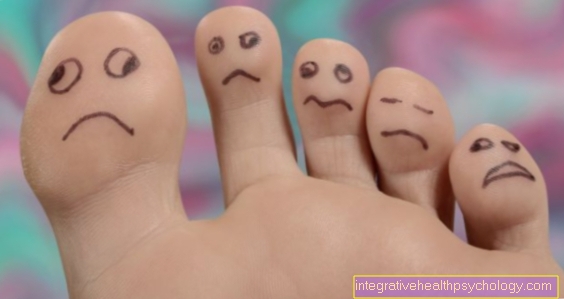


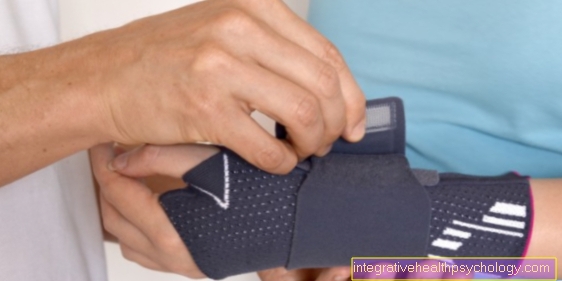






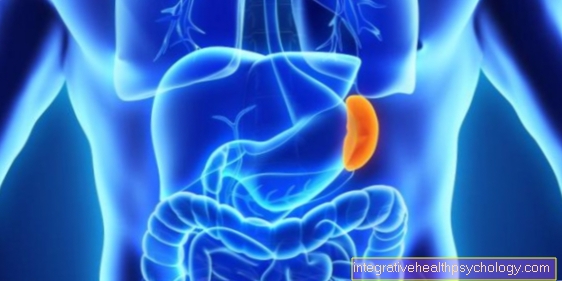

.jpg)






